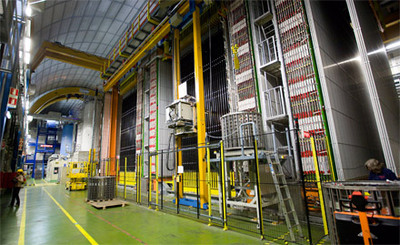 |
A view of the OPERA detector in Gran Sasso, Italy.
Neutrino beams from CERN in Switzerland are sent over 700km through the Earth's crust to the laboratory in Italy.
Photo courtesy CERN PhotoLab |
| |
Geneva, Switzerland - September 23, 2011
The OPERA experiment, which observes a neutrino beam from CERN 730 km away at Italy’s INFN Gran Sasso Laboratory, will present new results in a
seminar at CERN this afternoon at 16:00 CEST.
The seminar will be webcast at http://webcast.cern.ch
Journalists wishing to ask questions may do so
via twitter using the hash tag
#nuquestions,
or via the usual CERN press office channels.
 |
The OPERA detector in Gran Sasso, Italy.
Lateral view of OPERA
Photo courtesy CERN PhotoLab |
| |
The OPERA result is based on the observation of over 15000 neutrino events measured at Gran Sasso, and appears to indicate that the neutrinos travel at a velocity 20 parts per million above the speed of light, nature’s cosmic speed limit.
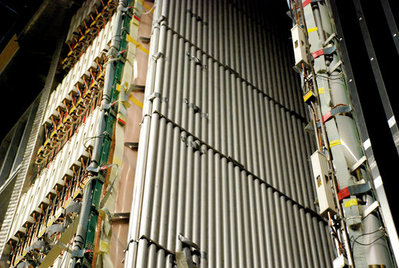 |
The OPERA detector in Gran Sasso, Italy.
HPT - High Precision drift tube for particle momentum reconstruction.
Photo courtesy CERN PhotoLab |
| |
Given the potential far-reaching consequences of such a result, independent measurements are needed before the effect can either be refuted or firmly established.
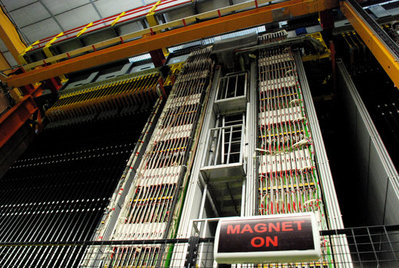 |
The OPERA detector in Gran Sasso, Italy. MAGNET
Photo courtesy CERN PhotoLab |
| |
This is why the OPERA collaboration has decided to open the result to broader scrutiny.
The collaboration’s result is available on the
preprint server arxiv.org:
http://arxiv.org/abs/1109.4897
 |
The OPERA detector in Gran Sasso, Italy.
RPC - Resistive Plate Chamber among the magnet irons slabs.
Photo courtesy CERN PhotoLab |
| |
The OPERA measurement is at odds with well-established laws of nature, though science frequently progresses by overthrowing the established paradigms.
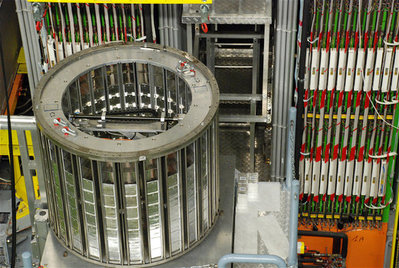 |
The OPERA detector in Gran Sasso, Italy.
Brick loading station
Photo courtesy CERN PhotoLab |
| |
For this reason,
many searches have been made for deviations from Einstein’s theory of relativity, so far not finding any such evidence.
The strong constraints arising from these observations makes an interpretation of the OPERA measurement in terms of modification of Einstein’s theory unlikely, and give further strong reason to seek new independent measurements.
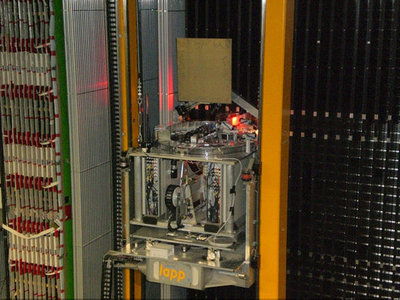 |
The OPERA detector in Gran Sasso, Italy.
BMS - Brick Manipulator System
Photo courtesy CERN PhotoLab |
| |
“This result comes as a complete surprise,” said
OPERA spokesperson, Antonio Ereditato of the University of Bern.
“After many months of studies and cross checks we have not found any instrumental effect that could explain the result of the measurement. While OPERA researchers will continue their studies, we are also looking forward to independent measurements to fully assess the nature of this observation.”
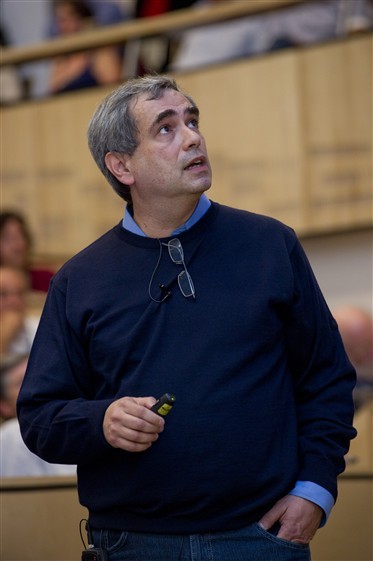 |
CERN Geneva. Seminar on OPERA results given by Dario Autiero (CNRS), 23 September 2011.
Photo courtesy CERN PhotoLab |
| |
“When an experiment finds an apparently unbelievable result and can find no artefact of the measurement to account for it, it’s normal procedure to invite broader scrutiny, and this is exactly what the OPERA collaboration is doing, it’s good scientific practice,” said
CERN Research Director Sergio Bertolucci.
“If this measurement is confirmed, it might change our view of physics, but we need to be sure that there are no other, more mundane, explanations. That will require independent measurements.”
 |
CERN Geneva. Seminar on OPERA results given by Dario Autiero (CNRS), 23 September 2011.
Photo courtesy CERN PhotoLab |
| |
In order to perform this study, the OPERA Collaboration teamed up with experts in metrology from CERN and other institutions to perform a series of high precision measurements of the distance between the source and the detector, and of the neutrinos’ time of flight.
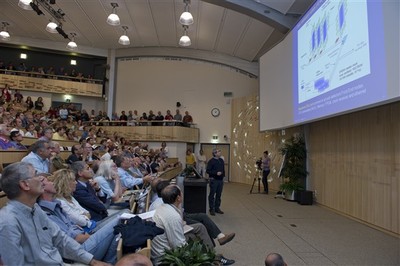 |
CERN Geneva. Seminar on OPERA results given by Dario Autiero (CNRS), 23 September 2011.
Photo courtesy CERN PhotoLab |
| |
The distance between the origin of the neutrino beam and OPERA was measured with an uncertainty of 20 cm over the 730 km travel path.
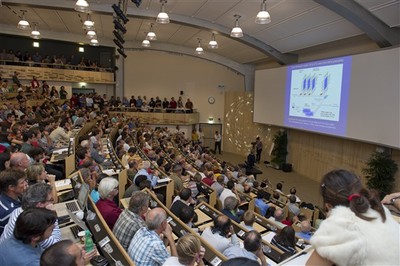 |
CERN Geneva. Seminar on OPERA results given by Dario Autiero (CNRS), 23 September 2011.
Photo courtesy CERN PhotoLab |
| |
The neutrinos’ time of flight was determined with an accuracy of less than 10 nanoseconds by using sophisticated instruments including advanced GPS systems and atomic clocks.
The time response of all elements of the CNGS beam line and of the OPERA detector has also been measured with great precision.
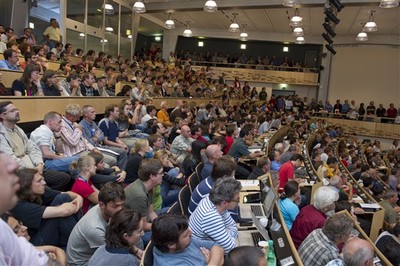 |
CERN Geneva. Seminar on OPERA results given by Dario Autiero (CNRS), 23 September 2011.
Photo courtesy CERN PhotoLab |
| |
"We have established synchronization between CERN and Gran Sasso that gives us nanosecond accuracy, and we’ve measured the distance between the two sites to 20 centimetres,” said
Dario Autiero, the CNRS researcher who will give this afternoon’s seminar.
“Although our measurements have low systematic uncertainty and high statistical accuracy, and we place great confidence in our results, we’re looking forward to comparing them with those from other experiments."
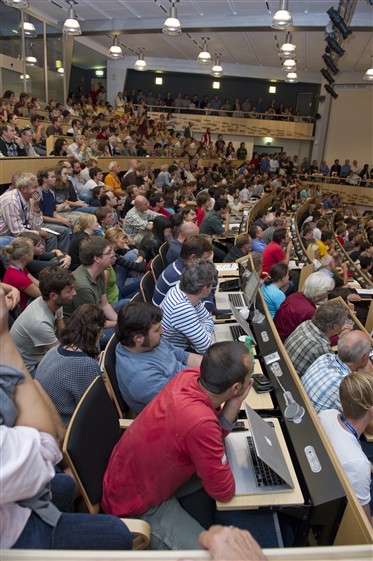 |
CERN Geneva. Seminar on OPERA results given by Dario Autiero (CNRS), 23 September 2011.
Photo courtesy CERN PhotoLab |
| |
“The potential impact on science is too large to draw immediate conclusions or attempt physics interpretations. My first reaction is that the neutrino is still surprising us with its mysteries.” said
Ereditato.
“Today’s seminar is intended to invite scrutiny from the broader particle physics community.”
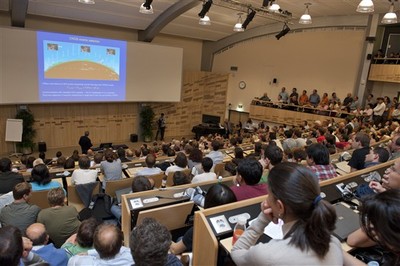 |
CERN Geneva. Seminar on OPERA results given by Dario Autiero (CNRS), 23 September 2011.
Photo courtesy CERN PhotoLab |
| |
The OPERA experiment was inaugurated in 2006, with the main goal of studying the rare transformation (oscillation) of muon neutrinos into tau neutrinos.
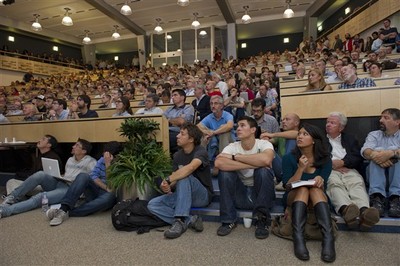 |
CERN Geneva. Seminar on OPERA results given by Dario Autiero (CNRS), 23 September 2011.
Photo courtesy CERN PhotoLab |
| |
One first such event was observed in 2010, proving the unique ability of the experiment in the detection of the elusive signal of tau neutrinos.
Contact:
CERN Press Office
press.office@cern.ch
+41 22 767 34 32
+41 22 767 21 41
Follow CERN at:
www.cern.ch
http://twitter.com/cern/
http://www.youtube.com/user/CERNTV
http://www.quantumdiaries.org/
About OPERA
OPERA has been designed and is being conducted by a team of researchers from Belgium, Croatia, France, Germany, Israel, Italy, Japan, Korea, Russia, Switzerland and Turkey.
The experiment constitutes a complex scientific enterprise that has been realised thanks to the skill of a large number of scientists, engineers, technicians and students, and with the strong commitment of the various actors of the project.
In particular we mention the
LNGS/INFN and
CERN laboratories, and the major financial support of
Italy and
Japan with substantial contributions from
Belgium, France, Germany and
Switzerland.
The OPERA Collaboration presently includes about 160 researchers from 30 institutions and 11 countries:
• IIHE-ULB Brussels, Belgium
• IRB Zagreb, Croatia
• LAPP Annecy, France
• IPNL Lyon, France
• IPHC Strasbourg, France
• Hamburg, Germany
• Technion Haifa, Israel
• Bari, Italy
• Bologna, Italy
• LNF, Italy
• L’Aquila, Italy
• LNGS, Italy
• Naples, Italy
• Padova, Italy
• Rome, Italy
• Salerno, Italy
• Aichi, Japan
• Toho, Japan
• Kobe, Japan
• Nagoya, Japan
• Utsunomiya, Japan
• GNU Jinju, Korea
• INR RAS Moscow, Russia
• LPI RAS Moscow, Russia
• ITEP Moscow, Russia
• SINP MSU Moscow, Russia
• JINR Dubna, Russia
• Bern, Switzerland
• ETH Zurich, Switzerland
• METU Ankara, Turkey.
About CERN
CERN, the European Organization for Nuclear Research, is the world's leading laboratory for particle physics.
It has its headquarters in Geneva.
At present, its Member States are:
• Austria
• Belgium
• Bulgaria
• the Czech Republic
• Denmark
• Finland
• France
• Germany
• Greece
• Hungary
• Italy
• the Netherlands
• Norway
•
Poland
• Portugal
• Slovakia
• Spain
• Sweden
• Switzerland
• the United Kingdom.
Romania is a
candidate for accession.
India, Israel, Japan, the Russian Federation, the United States of America, Turkey, the European Commission and
UNESCO have
Observer status.
Source: CERN
http://press.web.cern.ch/
ASTROMAN Magazine - 2010.03.06
Wielki Zderzacz Hadronów (LHC) w CERN ponownie w akcji
http://www.astroman.com.pl/index.php?mod=magazine&a=read&id=674
ASTROMAN Magazine - 2010.02.08
Polscy naukowcy modernizują akceleratory w CERN
http://www.astroman.com.pl/index.php?mod=magazine&a=read&id=660

